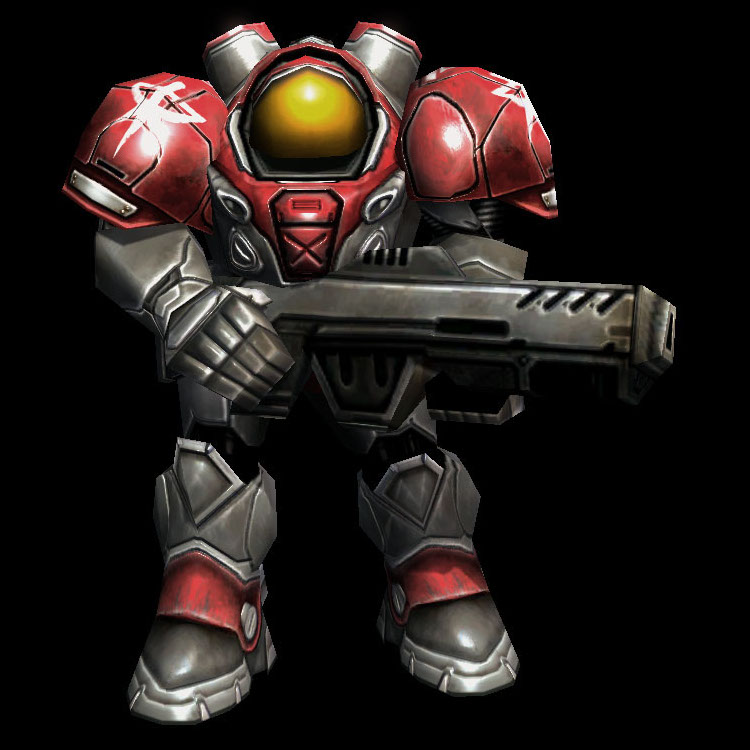- Joined
- Mar 18, 2007
- Messages
- 2,247
Hey guys, just thought I'd start up this thread as a tutorial/discussion/help thread. I'll be putting stuff in here piece by piece as I go. What I'll mainly be doing is explaining the process of making a game model, and probably won't delve too deep into explaining how to use individual programs. There are plenty of tutorials online for that (well, as well for what I'm talking about but oh well) and I'll try to link them. I'll just start off with a basic introduction.
Modeling 3d assets for current games, like SC2, is definitely a much bigger challenge than making models and textures for WC3. A lot of skill sets are required. Some of the programs that I will be talking about are:
3ds Max - modeling
Zbrush - sculpting/texturing
Photoshop - texturing
CrazyBump - normal map generation
There are many other programs that can be used, but these are the ones that I prefer. Others include:
Maya - modeling
Mudbox - sculpting/texturing
Sculptris - sculpting/texturing (and free!)
nDo2 - similar to CrazyBump, used for normal map generation
XNormal - used for baking normal maps and generating other map types; it's a handy tool to use
Keep in mind that I'll just be talking about modeling here, not animation.
As a side note, because of the fortunate RTS perspective of SC2, things can be made much simpler due to the distance of the model being viewed.
Unlike WC3, which just uses a diffuse (texture) map, many more maps are now used to form the material as a whole. These maps include:
Diffuse map - the texture of a model; the colors
Alpha map - used for transparency (I'm sure that most are familiar with this, I hope)
Specular map - helps define material definition of a model through the intensity and color of highlights
Normal map - simply put, fakes lighting to simulate higher detail on a low poly model
Emissive/glow map - creates glow/light on a texture of a designated brightness and color
These maps are made by a variety of methods:
-Painting
-Sculpting and baking
-Generating in a program
-A mixture of these methods
There are also more map types than these, but these are the ones that you'll primarily need to know for now. I'll further explain the ones listed as I go.
I'll talk about my first (and probably the most important) phase of making a model next:
Concepting/Blocking Out
Modeling 3d assets for current games, like SC2, is definitely a much bigger challenge than making models and textures for WC3. A lot of skill sets are required. Some of the programs that I will be talking about are:
3ds Max - modeling
Zbrush - sculpting/texturing
Photoshop - texturing
CrazyBump - normal map generation
There are many other programs that can be used, but these are the ones that I prefer. Others include:
Maya - modeling
Mudbox - sculpting/texturing
Sculptris - sculpting/texturing (and free!)
nDo2 - similar to CrazyBump, used for normal map generation
XNormal - used for baking normal maps and generating other map types; it's a handy tool to use
Keep in mind that I'll just be talking about modeling here, not animation.
As a side note, because of the fortunate RTS perspective of SC2, things can be made much simpler due to the distance of the model being viewed.
Unlike WC3, which just uses a diffuse (texture) map, many more maps are now used to form the material as a whole. These maps include:
Diffuse map - the texture of a model; the colors
Alpha map - used for transparency (I'm sure that most are familiar with this, I hope)
Specular map - helps define material definition of a model through the intensity and color of highlights
Normal map - simply put, fakes lighting to simulate higher detail on a low poly model
Emissive/glow map - creates glow/light on a texture of a designated brightness and color
These maps are made by a variety of methods:
-Painting
-Sculpting and baking
-Generating in a program
-A mixture of these methods
There are also more map types than these, but these are the ones that you'll primarily need to know for now. I'll further explain the ones listed as I go.
I'll talk about my first (and probably the most important) phase of making a model next:
Concepting/Blocking Out






